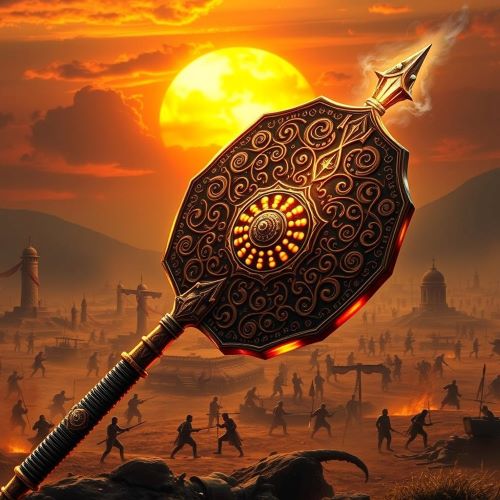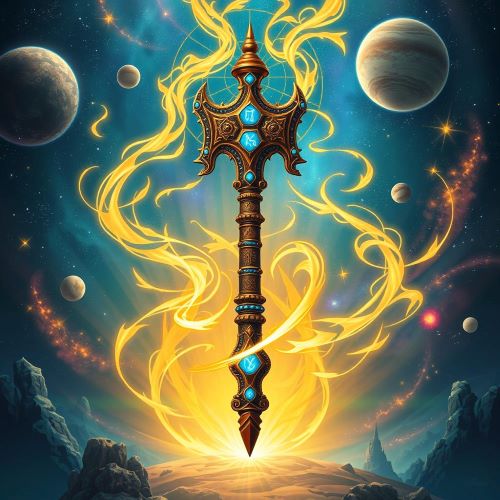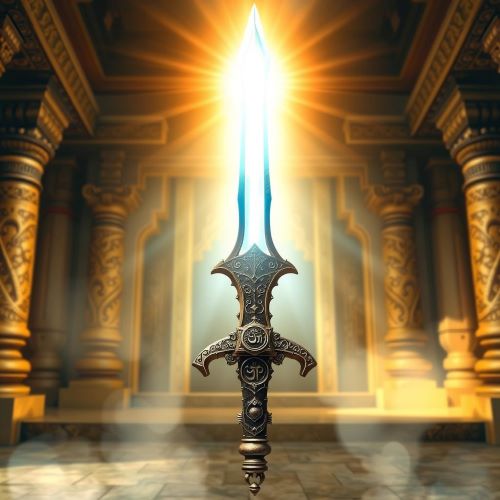Kanabo : The Crushing Mace
Kanabo
Introduction
The Kanabo is more than just a weapon—it’s an enduring symbol of brute force and unshakable dominance in both Japanese history and mythology. Known for its massive, spiked design and fearsome reputation, the Kanabo was not only used by samurai and martial monks on the battlefield but also became a signature tool of supernatural beings like the oni—demon-like creatures of folklore. This legendary war club stands at the crossroads of cultural tradition, martial heritage, and mythological storytelling.
Origins
The Kanabo’s design speaks volumes about the needs of its time. Emerging during Japan’s feudal era—particularly around the 14th century—the weapon evolved from simpler wooden clubs to iron-reinforced instruments of destruction. Its core purpose was straightforward: to deliver raw, concussive power capable of smashing through the increasingly sophisticated armor worn by rival warriors.
Crafted from solid oak or dense iron, early versions ranged in size and shape, from handheld rods to giant two-handed clubs. The kanji for kanabō literally translates to “metal stick,” emphasizing its weighty, formidable nature. Though primarily associated with samurai, the weapon was also wielded by sōhei (warrior monks) and even bandits, attesting to its popularity and effectiveness across different groups.
The Kanabo wasn’t just practical—it was symbolic. To wield one was to declare physical dominance, and it often featured in ceremonies or martial parades as a representation of strength and authority.
Think you know your myths and legends? Dive into the world of ancient stories and test your knowledge with our engaging quizzes on Mythlok!
Powers
Unlike the razor precision of a katana, the Kanabo relied purely on mass and momentum. This war club didn’t cut—it crushed. A well-placed blow could crumple metal armor, break limbs, or even down a horse. The weapon’s studded or spiked head concentrated force into smaller areas, increasing the devastation with each strike.
Its psychological power was just as significant. Seeing a warrior—or worse, a monstrous oni—bearing a massive Kanabo was enough to shake enemy morale. The weapon symbolized not just the power to win, but the power to dominate.
In folklore, the Kanabo often possessed otherworldly strength. Myths describe oni leveling buildings with a single swing or scattering entire armies. Over time, these exaggerated depictions reinforced the idea that the Kanabo was a weapon of unstoppable force—something no man, or even god, could easily defy.
Owners/Users
The image of the oni wielding a Kanabo is perhaps the most iconic. Oni are typically portrayed as towering humanoids with brightly colored skin—red, blue, or green—and grotesque features. Their Kanabo is often just as large as they are, amplifying their already terrifying presence. The saying “oni ni kanabō”—”like giving a Kanabo to an oni”—means giving even more power to someone who’s already overwhelmingly strong.
But myth wasn’t the only place the Kanabo left its mark. Historical records speak of real-life warriors who used variations of the Kanabo in actual combat. Samurai like Akiyama Mitsumasa and Mogami Yoshiaki are believed to have wielded it during conflicts in the 14th and 16th centuries. These weren’t common foot soldiers; they were elite fighters who chose the Kanabo for its ability to overpower foes quickly.
Saito Musashibou Benkei, a legendary warrior monk, is another figure often associated with the Kanabo. Known for his loyalty and immense strength, Benkei was said to have carried a selection of weapons—one of which was the dreaded iron club.
Instances used
Though primarily a combat weapon, the Kanabo also played a role in psychological and symbolic warfare. During sieges, it was used to break gates or destroy defensive structures. Its sheer size and weight made it suitable for close-range, high-impact fighting, particularly in cramped battlefield conditions where swords and polearms could be less effective.
Beyond war, the Kanabo was occasionally used in rituals or demonstrations of martial strength. Carrying or displaying one was a visual metaphor for power, often seen during festivals or in martial arts exhibitions.
In folklore, its use extended into moral storytelling. Oni carrying Kanabo would often serve as cautionary figures—punishers of the wicked or embodiments of uncontrolled violence. These tales emphasized the dual nature of power: beneficial when controlled, destructive when unleashed recklessly.
Frequently Asked Questions
Lorem ipsum dolor sit amet, consectetur adipiscing?
Lorem ipsum dolor sit amet, consectetur adipiscing elit. Praesent convallis vestibulum justo, ac tincidunt nunc vehicula quis. Nullam id dolor quis orci malesuada feugiat. Curabitur aliquet libero at urna ullamcorper, ac ultricies nulla dapibus.
Lorem ipsum dolor sit amet, consectetur adipiscing?
Lorem ipsum dolor sit amet, consectetur adipiscing elit. Praesent convallis vestibulum justo, ac tincidunt nunc vehicula quis. Nullam id dolor quis orci malesuada feugiat. Curabitur aliquet libero at urna ullamcorper, ac ultricies nulla dapibus.
Lorem ipsum dolor sit amet, consectetur adipiscing?
Lorem ipsum dolor sit amet, consectetur adipiscing elit. Praesent convallis vestibulum justo, ac tincidunt nunc vehicula quis. Nullam id dolor quis orci malesuada feugiat. Curabitur aliquet libero at urna ullamcorper, ac ultricies nulla dapibus.
Lorem ipsum dolor sit amet, consectetur adipiscing?
Lorem ipsum dolor sit amet, consectetur adipiscing elit. Praesent convallis vestibulum justo, ac tincidunt nunc vehicula quis. Nullam id dolor quis orci malesuada feugiat. Curabitur aliquet libero at urna ullamcorper, ac ultricies nulla dapibus.
Lorem ipsum dolor sit amet, consectetur adipiscing?
Lorem ipsum dolor sit amet, consectetur adipiscing elit. Praesent convallis vestibulum justo, ac tincidunt nunc vehicula quis. Nullam id dolor quis orci malesuada feugiat. Curabitur aliquet libero at urna ullamcorper, ac ultricies nulla dapibus.
Watch
Source
Gunbai Military History Blog. (2018, April 23). Kanabou (金棒) – The Samurai’s Mace. Retrieved from http://gunbai-militaryhistory.blogspot.com/2018/04/kanabou-samurais-mace.html
Black Belt Wiki. (2015, May 7). Kanabo – Japanese Mace Weapon. Retrieved from https://blackbeltwiki.com/kanabo
Ashkenazi, M. (2003). Handbook of Japanese Mythology. ABC-CLIO.
Kanabo | Sonic Fanon Wiki – Fandom. (2008). Kanabo: Weapon Users. Retrieved from https://sonicfanon.fandom.com/wiki/Category:Weapon_Users:Kanabo
Deepwoken Wiki. (2025, January 18). Kanabo. Retrieved from https://deepwoken.fandom.com/wiki/Kanabo
JBC Studios Wiki. (2025, March 29). Kanabo. Retrieved from https://jbcstudios.miraheze.org/Kanabo
Makoto Swords. (2024, April 22). The Kanabō: The Japanese Weapon With A Rich History. Retrieved from https://makotoswords.com/blogs/news/the-kanabo-the-japanese-weapon-with-a-rich-history
TrueKatana. (2023, April 26). The Kanabō: The Japanese Weapon With A Rich History. Retrieved from https://www.truekatana.com/blog/158/the-kanab-the-japanese-weapon-with-a-rich-history
Wikipedia Contributors. (n.d.). Kanabō. Wikipedia. Retrieved from https://en.wikipedia.org/wiki/Kanab%C5%8D








